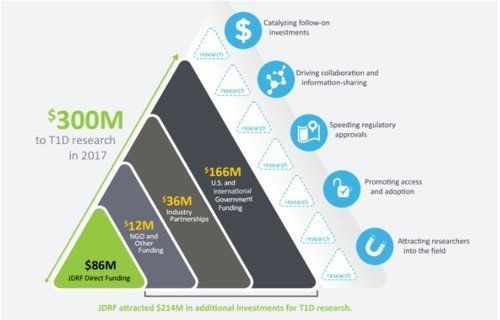
Last week, the JDCA published a report on JDRF’s 2017 audited financial statements which showed that JDRF spent $79 million on research grants, 38 percent of their annual income. This number is down from 44 percent in 2014 and 67 percent from the 2008 peak year. This decline appears to be the result of a strategic shift away from prioritizing research, even though the majority of donors want their gifts to be used to fund T1D research (See Appendix A).
At the same time, JDRF asserts in the 2017 Annual Report that they were pivotal to delivering $300 million in total investments for T1D research during 2017. (See JDRF-derived infographic above) (Click here to view the full 2017 JDRF Annual Report).
The assertion that JDRF was responsible for $300 million dollars of research spending in 2017, rather than the $79 million reported in their audited financial statements, seems to be a direct response to public pressure to increase research spending. Claiming $300 million in T1D research funding shifts the communication away from the decline in direct funding, which to date, has never been publicly addressed or explained to donors.
The remainder of this report will address this discrepancy.
Highlights and Commentary
On page 13 of the annual report JDRF quotes: “In the fiscal year 2017, JDRF attracted more than $214 million in funding from partners, bringing a total of $300 million to T1D research.” The JDRF chart above illustrates that statement. The question is how much credit does JDRF deserve, and is their claim that they are responsible for $214 million in additional investments for T1D research accurate or misleading? Excluding the $86m in JDRF Direct Funding, which can be tied to specific grants and investment returns listed in their 990-tax form, JDRF does not provide any transparency to the remaining $214m.
JDRF Direct Funding: $86 Million
This part of the chart shows the amount of research that JDRF directly funds.
- $79m is attributable to research grants. Details and information about these grants are transparent and easily available. Expenditures for these initiatives comes from the annual operating budget.
- $7m is attributable to the JDRF T1D Fund which invests in commercial for-profit ventures. Expenditures for these funds come out of an investment pool.
NGO and Other Funding: $12 Million
Very few details are provided about these activities and their impact, and there is no evidence that JDRF is an essential part of these initiatives.
- NGOs can be defined as a non-profit, international organization independent of government influence, or a voluntary citizens group. JDRF does not list or explain which NGOs it supports or helps.
- This number is not addressed or detailed in JDRF’s annual report, audited financial statements, or 990-tax form.
Industry Partnerships: $36 Million
JDRF refers to industry partnerships as projects that the organization is undertaking in conjunction with other corporations. This appears to be separate from the direct grants JDRF made to private, for-profit organizations and separate from the money invested through the T1D fund.
At least one example shared in the annual report would suggest that these initiatives directly benefited from JDRFs involvement. In 2017, JDRF partnered with IBM to utilize “the power of machine learning to unlock the science around T1D progression.”
- This number is not addressed or explained in JDRF’s annual report, audited financial statements, or 990-tax form.
- No details are provided about how the $36 million is determined, the strategic and tactical objectives of this initiative, or the impact this time and effort elicited in 2017.
- In 2016, the most recent year this data is available, over 12.5 percent of JDRF’s total $75m research budget went to for-profit, private companies.
U.S. and International Government Funding: $166 Million
This figure represents the single largest source of funding for T1D research. Although JDRF plays an important role in advocating and lobbying for U.S. and International Government Funding, credit must be shared by many organizations and individuals.
The majority of the $166m figure comes from the renewal of the Special Diabetes Program (SDP), which accounts for $150m of the $166m. On page 15 of the annual report, JDRF quotes: “We advocated for a multi-year renewal of the Special Diabetes Program (SDP), which provides $150 million annually for critical T1D research through the National Institutes of Health (NIH).”
JDRF seems to suggest that advocating for SDP is the reason that their direct research spending has declined over the last decade. However, SDP was first established in 1997, long before JDRF began to reduce their direct research spending. During most of those years, JDRF used 55-65 percent of its revenue to fund research grants. Therefore, either JDRF has become much less effective at lobbying or the decrease in research spending is not related to advocacy for SDP.
In addition, as of publication of this report, SDP was not included in the reauthorization of CHIP (Children’s Health Insurance Program) and is not currently included in the most recent federal budget discussions. If the federal budget is approved as it stands now, SDP funding will not continue.
Conclusion
As mentioned above, there is little-to-no visibility to any portion of the $214m in claimed additional investments for T1D. The JDCA believes JDRF has a moral and fiduciary duty to donors to clearly identify where all figures, infographics, and financial statements are sourced so donors can make accurate and informed decisions— and when needed, raise concerns.
Appendix A:
A JDCA survey of 3000+ T1D donors found:
- 96 percent of survey respondents said: “The majority (more than 50 percent) of the money raised through T1D fundraising events and individual donations should be used for T1D cure research.
- 79 percent of survey respondents said: “All (100 percent) of the money raised through T1D fundraising events (such as walks, rides, galas) and individual donations should be used for T1D cure research.
